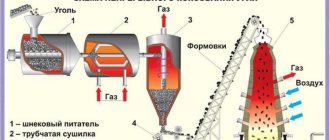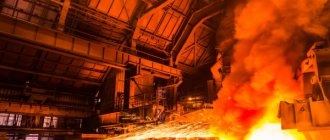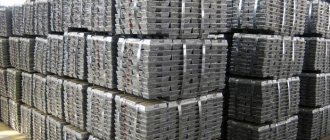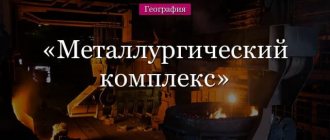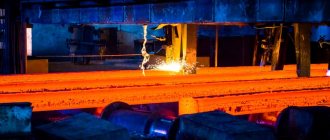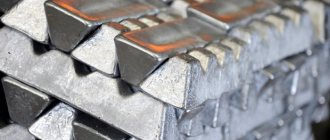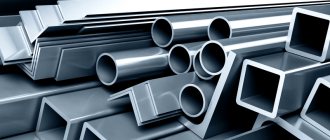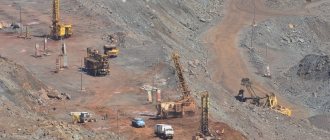Lesson plan:
Ferrous metallurgy
Non-ferrous metallurgy
Today, ferrous metallurgy plays an important role in the heavy industry of the Russian Federation. It is ferrous metals that hold the lead and are the main raw materials for the manufacture of various metal structures and products. This industry is important for the economy of any country, because the extracted raw materials are used to produce cast iron, various types and grades of steel, and rolled metal. This industry includes the beneficiation and extraction of ore materials, the extraction of non-metallic raw materials, and the installation of refractories.
Introduction
Ferrous metallurgy primarily serves as the basis for the development of mechanical engineering and metalworking. Ferrous metallurgy products are used in almost all areas of the modern economy. This branch of heavy industry covers such stages of the technological process as mining, beneficiation and agglomeration of ferrous metal ores, production of refractories, extraction of non-metallic raw materials for ferrous metallurgy, coking of coal, production of cast iron, steel, rolled products, ferroalloys, secondary processing of ferrous metals, extraction of auxiliary materials , production of metal products for industrial purposes, etc. But the basis of ferrous metallurgy is the production of cast iron, steel and rolled products.
The purpose of this test is to examine the importance of ferrous metallurgy in the country's economy, the characteristics and conditions of location, and the main metallurgical bases of Russia.
The topic “Development and deployment of Russian ferrous metallurgy” is relevant, since the Russian Federation occupies one of the leading places in the world in the extraction of iron ore, iron smelting, and coke production. The largest consumers of ferrous metallurgy products are mechanical engineering and metalworking, the construction industry, and railway transport. Ferrous metallurgy is closely connected with the chemical and light industries.
An important task of this test is to consider the problems of environmental protection and rational use of natural resources in the industry, as well as to identify directions for the development and placement of ferrous metallurgy in a market economy.
Raw material base
Domestic metallurgy is developing thanks to the wealth of minerals that fill the bowels of the state.
Numerous deposits of coking coal fully satisfy the needs of metallurgists. Most Ural plants operate on coal supplied from the Kuznetsk coal basin (Kuzbass).
In terms of iron ore reserves, the Russian Federation is now in first place in the world. Its territory contains about 19% of the world's reserves of this mineral. Large deposits of iron ore are called an iron ore basin. The largest examples of them in the post-Soviet space are:
- Krivoy Rog iron ore basin;
- iron ore basin of the southern Urals;
- Kursk magnetic anomaly.
Experts develop iron ore deposits using open (quarry) and underground (mine) methods.
The feasibility of developing deposits of coal or ferruginous quartzite is determined by the depth of the deposits, transport accessibility of the deposit, as well as technological parameters.
Having considered the factors (not only raw materials) influencing the choice of location for metallurgical plants.
The importance of ferrous metallurgy in the country's economy
The development of the modern economy follows the path of formation of inter-industry complexes. These include the metallurgical complex, which consists of 2 industries (ferrous and non-ferrous metallurgy). Both sectors are of enormous national economic importance, they are among the basic and strategically important ones, without which the development of any branch of the national economy is impossible, since they are the basis of mechanical engineering. These sectors determine the level of national security and defense capability of the country.
Many large metallurgical enterprises, in conditions of a deep economic crisis, are the basis for supporting the economy of entire regions of Russia.
The metallurgical complex plays a significant role in the Russian economy. Its share in the country's industrial production is 19.3%, with a share in fixed assets of industry - 11.1%, in numbers - 9.3%. The share in exports is about 18% (this is second place after the fuel and energy sector). The balanced financial result of the complex is 40.4% of the total for the industry, which is quite comparable to the share of the fuel and energy complex (42%).
The metallurgical industry of Russia is distinguished by a high degree of concentration of production; about 90% of products in ferrous metallurgy are produced by six large companies, in non-ferrous metallurgy - by five.
Russia ranks 4th in the world in steel production (behind China, Japan and the USA), and 2nd in the world in exports of metal products. Russia ranks second in the world in the production and export of aluminum, second only to the United States, and first in nickel production.
The ferrous metallurgy of Russia includes enterprises and organizations for the extraction and processing of ore and non-metallic materials; production of cast iron, steel, rolled products, pipes, hardware, ferroalloys, refractories, coke, and a number of types of chemical products; procurement and processing of scrap and ferrous metal waste; repair of mechanical and power equipment; transportation of in-plant cargo, as well as scientific and design organizations.
The dynamics of development of ferrous metallurgy can be traced according to Table 1:
table 1. PRODUCTION OF MAIN TYPES OF METALLURGICAL PRODUCTS (million tons)
| 1970 | 1980 | 1990 | 1995 | 2000 | 2001 | 2002 | 2003 | 2004 | 2005 | 2006 | 2007 | |
| Cast iron | 42,0 | 55,2 | 59,4 | 39,8 | 44,6 | 45,0 | 46,7 | 48,8 | 50,4 | 49,2 | 52,4 | 51,5 |
| Steel | 63,9 | 84,4 | 89,6 | 51,6 | 59,2 | 59,0 | 59,9 | 62,8 | 65,6 | 66,3 | 70,8 | 72,4 |
| Ready rolled ferrous metals | 43,2 | 59,7 | 63,7 | 39,0 | 46,7 | 46,9 | 48,5 | 50,7 | 53,7 | 54,7 | 58,2 | 59,6 |
| Steel pipes: | ||||||||||||
| million tons | 7,0 | 10,7 | 11,9 | 3,8 | 5,0 | 5,4 | 5,2 | 6,1 | 6,0 | 6,7 | 7,9 | 8,7 |
| million m | 1414 | 1963 | 2180 | 630 | 823 | 881 | 908 | 1022 | 1023 | 1052 | 1169 | 1268 |
Production characteristics
The task of ferrous metallurgy, in addition to the production of metals, includes the processing of a number of related materials. This includes coke, refractories and various ores.
If we exclude the production of non-ferrous metals, then the main features of ferrous metallurgy stand out. These include:
- More than a third of all products are used in mechanical engineering.
- The fourth part goes to the production of building load-bearing structures.
- High capital intensity of production.
- Dependence on raw materials. It accounts for about 90% of all costs.
The resulting metallurgical products have different varieties. A brief description of them is presented in the table.
| Smelted metals | Black | Cast iron |
| Steel | ||
| Colored | Noble. These include gold, silver, platinum. | |
| Heavy. Among them are copper, zinc, and tin. | ||
| Lungs. This is aluminum, magnesium. | ||
| Rare. Among them are titanium, tungsten, zirconium, and molybdenum. |
If you look at which country is the world leader in steel production, China leads by a wide margin. It produces 928 million tons per year. Russia produces 71 million tons. At the same time, such a developed country as the USA produces 86 million tons of steel. However, whatever these indicators are, they are often conditional and do not provide an objective definition of the level of development of the state.
The region-forming role of ferrous metallurgy
Ferrous metallurgy with a full technological cycle is an important regional-forming factor. In addition to numerous industries arising from the recycling of various types of waste during iron smelting and coal coking - heavy organic synthesis (benzene, anthracene, naphthalene, ammonia and their derivatives), the production of building materials (cement, block products), Thomas flour (for the redistribution of iron ores with a high phosphorus content), ferrous metallurgy attracts related industries. Its most typical satellites are: thermal power engineering, primarily installations that are part of metallurgical plants and can operate on by-product fuel (excess blast furnace gas, coke, coke breeze); metal-intensive mechanical engineering (metallurgical and mining equipment, heavy machine tools). Ferrous metallurgy forms around itself such powerful and diversified industrial complexes that arose in the Urals and Kuzbass.
Fuel and raw material base of ferrous metallurgy
The natural basis of ferrous metallurgy are sources of metal raw materials and fuel. Russia is well supplied with raw materials for the development of ferrous metallurgy. Most of the explored iron ore deposits are rich (not requiring beneficiation) and easily beneficiated, with an average iron content of 36.9%. But iron resources and fuel are distributed unevenly across the country. More than 50% of all balance iron ore reserves are concentrated in the European part of the Russian Federation.
The Kursk magnetic anomaly (Central Black Earth economic region) is the largest iron ore basin. Its balance reserves amount to 43 billion tons. The total geological reserves of rich ores (with an iron content of 56-66%) are estimated at 65 billion tons. 80% of the rich iron ore reserves of the KMA and 40% of all explored reserves of these ores in Russia are concentrated in the Belgorod region. The region's naturally rich iron ore is recognized as the best in quality in the world. It contains a minimum of sulfur and phosphorus impurities. The explored and estimated reserves of these ores amount to more than 60 billion tons. The reserves for the Lebedinsky Mining and Processing Plant (Gubkin) will last for 500 years.
However, the KMA ores are covered by a thick layer of highly watered rocks, which worsens the mining and hydrogeological conditions of their development. Nevertheless, compared to the deposits of the Urals and Eastern Siberia, the reduced costs per 1 ton of marketable ore at KMA enterprises are 20-35% lower. But the development of iron ore deposits in this region, especially by open-pit mining, leads to the irreversible loss of fertile lands.
The main iron ore reserves of the KMA are concentrated in the seven most explored deposits - Lebedinsky, Stoilensky, Chernyansky, Pogrometsky, Yakovlevsky, Gostishchevsky and Mikhailovsky.
On the Kola Peninsula and in Karelia, less significant deposits of iron ore with low (28-32%) iron content are exploited: Kovdorskoye, Olenegorskoye, Kostomuksha.
The iron ore resources of the Urals are significant; The deposits stretch in a wide strip from north to south parallel to the Ural ridge. These are the Kachkanarskaya (reserves amount to 6.1 billion tons), Tagilo-Kushvenskaya, Bakalskaya and Orsko-Khalilovskaya groups of fields.
Iron ore deposits have also been discovered in the eastern regions. In Western Siberia - the ores of Gornaya Shoria and Rudny Altai (reserves amount to more than 1 billion tons); in Eastern Siberia - the Angara-Pitsky, Angaro-Ilimsky basins, etc., located in the Angara region, Kuznetsk Alatau and Transbaikalia (balance reserves - more than 4 billion tons).
In the Far East, the Aldan iron ore province and the Olekmo-Amgunsky district in the Republic of Sakha (Yakutia), gravitating towards the Baikal-Amur Mainline, are promising. The bulk of the region's iron ores (80%) are concentrated in Yakutia.
Deposits of manganese ores are represented by Usinsky in Western Siberia, Polunochny in the Urals and small, poorly studied deposits in the Khabarovsk Territory.
Given the overall fairly large raw material base of iron ores, the areas experiencing their shortage are the Urals and Western Siberia, where it is necessary to continue geological exploration in order to strengthen the raw material base of existing enterprises.
Manganese and chromium ores are very scarce. The explored reserves of these metals in Russia account for 5 and 3% of the total reserves of the CIS, respectively, with needs being 40 and 38%. Currently, the needs for these ores are covered by imports from Ukraine and Kazakhstan.
In quantitative terms, in the European part, explored ores of ferrous metals significantly predominate over coal reserves; in the eastern regions, there is more fuel than raw material resources. A favorable combination of iron ores and coking coals is typical for Western Siberia (Gornaya Shoria - Kuzbass) and the Far East (Aldan basin - South Yakut basin).
Factors of location of ferrous metallurgy enterprises.
The territorial organization of the iron and steel industry is influenced by a number of factors.
1. Concentration of production.
2. Production combination. Consolidation of several interconnected production facilities from various industries into one enterprise.
3. Material intensity of production.
4. High energy intensity.
5. High labor costs at domestic metallurgical enterprises
6. Ferrous metallurgy enterprises with a full technological cycle are a powerful regional-forming factor.
7. Increasing spread of new directions.
Types of ferrous metallurgy enterprises and features of their location
full-cycle metallurgy is distinguished , producing cast iron - steel - rolled products. In addition to the main production, it includes the preparation of iron ore for smelting.
Raw materials and fuel play a particularly important role in the location of full-cycle metallurgy enterprises. Full-cycle ferrous metallurgy is located throughout the Russian Federation:
1) near sources of raw materials (Ural metallurgical base, metallurgical base of the central regions of the European part);
2) near fuel resources (West Siberian metallurgical base);
3) between sources of raw materials and fuel resources (Cherepovets Metallurgical Plant).
Incomplete cycle enterprises produce cast iron or steel or rolled products. Enterprises that produce steel without cast iron are called conversion enterprises . In pigment metallurgy, the raw material is mainly metal scrap. Therefore, such enterprises focus on areas with developed mechanical engineering and places where finished products are consumed.
The production of electric steels and ferroalloys is distinguished by special placement factors. Electric steels are produced near sources of electricity and metal scrap (Elektrostal, Moscow region). Ferroalloys - alloys of iron with alloying metals (manganese, tungsten, chromium) - are produced in blast furnaces or by the electrothermal method at metallurgical enterprises or at specialized plants (Chelyabinsk).
Features of the metallurgical process
A metallurgical plant is an enterprise with a full metallurgical cycle, including all three stages of the metallurgical process: iron smelting, steel production, rolling.
There are two types of metallurgical plants:
- plant producing steel and rolled products;
- a plant where iron and steel are produced.
The technological process for the production of steel and rolled products is a complex sequence, the stages of which are as follows:
Mining of iron ore, coking coal and limestone;
- ore dressing at mining and processing plants;
- coal coking;
- smelting cast iron in blast furnaces;
- steel production in oxygen converters or open-hearth furnaces;
- rolling steel ingots on crimping mills;
- rolling of blooms and slabs on section rolling, sheet rolling and pipe rolling mills.
The production of rolled metal is impossible without the presence of powerful energy resources. This factor stimulates the development of the electric power industry and other related sectors of the economy. Russia's electric power potential ensures the production of steel and rolled metal at dozens of factories and mills.
The blast furnace process requires specific carbon-containing fuel. This need is met by coke production.
The factors for locating ferrous metallurgy enterprises are determined by its basis – raw materials.
Characteristics of metallurgical bases in Russia
The totality of ferrous metallurgy enterprises (all types) located in one or neighboring areas, together with their raw material and fuel base, form ferrous metallurgy districts (bases).
In total, there are three such bases in Russia - Ural, Central, and Siberian.
The Ural base (Ural region) is the largest producer of ferrous metals in the country (about half of the production of cast iron, steel and rolled products). The ferrous metallurgy of the Urals uses imported fuel - coal from the Kuznetsk and Karaganda (Kazakhstan) basins, works on its own (ores from the Kachkanar and Bakalskoye deposits) and partly on imported raw materials (ores from the KMA and Sokolovo-Sarbaiskoye deposits in Kazakhstan). Iron ore mining at its own deposits is carried out by open-pit mining. Most of the metal produced here is produced by metallurgical plants (Magnitogorsk, Chelyabinsk, Nizhny Tagil, Novotroitsk). Pipe metallurgy (Ekaterinburg, Izhevsk, Zlatoust, Lysva, Serov, etc.), electrometallurgy of ferroalloys (Serov, Chelyabinsk) and pipe rolling (Pervouralsk, Kamensk-Uralsky) are more developed than in other regions. Naturally alloyed metals are being smelted (Novotroitsk, Verkhniy Ufaley). The cheapest metal in the country is produced. The Urals exports more than half of its ferrous metal products abroad.
The central base (Central Chernozem, Central and Volga-Vyatka regions) operates on KMA iron ores, scrap metal resources and imported fuel - coal from the Pechora, Kuznetsk and Donetsk (Rostov region) basins.
The Kursk Magnetic Anomaly (KMA) is the largest iron ore basin in the country, serves as a source of raw materials not only for factories in the Center, but also in the Northern and Ural regions, and also supplies ore for export. Most of the ore is mined by open pit mining. Along with rich ores, relatively iron-poor ferruginous quartzites (with an average iron content of about 32%) are also mined in large quantities. Iron ore mining is cheaper than in other areas. The largest mining and processing plants in the country and in the world have been created (Lebedinsky, Mikhailovsky, Stoilinsky GOK).
The Gubkinsky and Yakovlevsky mines operate to extract deep reserves. Full cycle plants - Novolipetsk and Novotulsky, produce most of the cast iron, steel and rolled products. Electrometallurgy has been developed (Oskol Electrometallurgical Plant in Stary Oskol, Belgorod Region with the technology of direct reduction of iron from metallized pellets), processing (and Elektrostal in Moscow and the Moscow Region, plants in Nizhny Novgorod, Vyksa and Kulebaki in the Volga-Vyatka region) and small ( Moscow) metallurgy. The smelting of cast iron and blast furnace ferroalloys is carried out (plants in Tula and Lipetsk), and the production of cold-rolled strip (Oryol Steel Rolling Plant).
Siberian base (West Siberian, East Siberian and Far Eastern regions). The raw material base is the iron ores of Mountainous Shoria, Khakassia, Angara-Ilimsky, Angara-Pitsky and Aldan basins. Fuel base - Kuzbass and South Yakutsk basin. There are large mining and processing plants - Korshunovsky and Rudnogorsk in the Irkutsk region. Metal production is represented by the Kuznetsk and West Siberian metallurgical plants (both located in Novokuznetsk), conversion plants (Novosibirsk, Guryevsk, Krasnoyarsk, Petrovsk-Zabaikalsky, Komsomolsk-on-Amur), and ferroalloy plants (Novokuznetsk).
The Siberian base is the youngest of the country's bases and is in the process of formation. The prospects for its development are associated with the construction of metallurgical plants in Eastern Siberia (Taishet) and the Far East.
A new metallurgical base began to form in the Northern region, namely in the city of Cherepovets, where one of the largest metallurgical plants in the country is located. The Cherepovets Metallurgical Plant uses iron ore from the Kola Peninsula (Kovdorsky and Olenegorsky Mining and Processing Plants) and Karelia (Kostomuksha Mining and Processing Plant), and coking coal from the Pechora basin. There is a conversion plant in St. Petersburg.
The Russian ferrous metallurgy is experiencing a shortage of manganese ores, large reserves and production of which are concentrated in the CIS in Ukraine (Nikopolskoye, Bolshoye Tokmakskoye deposits) and in Georgia (Chiaturskoye deposit). These same Commonwealth countries also stand out for the production of ferrous metals, represented by large plants in Krivoy Rog, Dnepropetrovsk, Dneprodzerzhinsk, Zaporozhye, Donetsk, Mariupol (in Ukraine) and Rustavi (Georgia), as well as ferroalloy plants in Zaporozhye (Ukraine) and Zestafoni (Georgia) ).
Historical information
To get an idea of the peculiarities of ferrous metal production, you need to look deep into history. This information can be obtained from reports, notes or abstracts written on the relevant topic. According to reports from various sources, industrial processing of metals has been carried out in Russia since the advent of the industrialists Demidovs. Before this, there was mainly artisanal metallurgy. Iron ore processing began at the newly built Ural plants.
After the revolution, ferrous metallurgy received an impetus for development. This happened during Stalin's industrialization. And in the post-war years, in addition to the Urals, the construction of metallurgical complexes spread widely to regions of Siberia.
ENERGY AND ECOLOGICAL PROBLEMS OF FERROUS METALLURGY
Resource conservation, environmental protection, and rational use of natural resources are becoming increasingly pressing problems in the development of iron ore and non-ferrous metal ore mining regions. Significant areas of land are occupied by dump zones. Reclamation is not ongoing in most areas. A third of the annual damage from land acquisition is due to the loss of agricultural products from these lands.
The integrated use of raw materials at all stages of their processing can become one of the sources of replenishment of resources. It has been determined that at least 30% of waste rocks and up to 40% of iron ore enrichment waste are suitable for the production of building materials and other products.
Dumps and slag ponds also become centers of constant dust, polluting the atmosphere and land. The pace of restoration of disturbed lands and their return to the national economy is still low, and the area of uncultivated land is growing.
Harmful emissions from mining enterprises negatively affect the condition of air, vegetation and soil. Norwegian ecologists call the Kola Peninsula with its factories the most polluted place on earth. The city that emits the largest amount of pollution per unit area is Norilsk. Emissions from its mining and processing plants reach the United States and Canada. Harmful emissions from enterprises of the Southern Urals were noted on the territory of Kazakhstan.
At the same time, western air currents bring acid precipitation to Russian territory from European countries, especially from Poland, the Czech Republic, Germany, Ukraine and Belarus. Thus, in 1993, 405 thousand tons of sulfur compounds fell in Russia, brought from Ukraine, mainly from the Dnieper-Krivoy Rog industrial region, Kharkov region and Donbass.
Criteria for choosing the location of non-ferrous metallurgy facilities
The geological factor is the main criterion influencing the location of plants for the production of non-ferrous metals. Due to the low proportion of useful components in non-ferrous metal ores, their transportation is not economically feasible.
This requires the location of factories in this industry in mining areas. Nickel production, for example, is strictly tied to the place of its extraction.
Such factors lead to the fact that production is located in unfavorable climatic conditions - in the Arctic Circle (Norilsk).
The development of non-ferrous metal deposits is often associated with a number of difficulties. Access to useful minerals is often blocked by a shield of waste rock and must be blasted. Such development requires the use of a large amount of equipment: excavators, conveyors, electric locomotives.
List of used literature.
1. Economic geography of Russia: Textbook. manual for universities, / Ed. T.G. Morozova. – 2nd ed., revised. and additional – M.: UNITY-DANA, 2001 – 471 p. (p.134)
2. Russian statistical yearbook. 2008/Statistical collection/Rosstat.-M., 2008
3. Economic geography of Russia: Textbook / Under the general editorship. acad. IN AND. Vidyapina. - M.: INFRA-M, Russian Economic Academy, 2000. - 533 p. - (Higher education). (p. 75-78)
4. Economic geography. textbook / edited by V.P. Zheltikov. Rostov-on-Don ed. "PHOENIX" 2001
5. “Allocation of productive forces”, ed. V.V.Kistanova, N.V.Kopyelova, M.: 1994.
Internet resources:
- https://www.minprom.gov.ru/activity/metal/strateg/2 DEVELOPMENT STRATEGY OF THE RUSSIAN METALLURGICAL INDUSTRY FOR THE PERIOD UNTIL 2020
- https://ru.wikipedia.org/wiki/Ferrous_metallurgy
Attention!
If you need help writing a paper, we recommend turning to professionals. More than 70,000 authors are ready to help you right now. Free adjustments and improvements. Find out the cost of your work
Free estimate
0
Size: 21.50K
Downloads: 107
01/13/11 at 10:17 Author: Solozenkova
Liked? Click on the button below. It's not difficult for you
, and we
are pleased
).
To download test papers for free at maximum speed, register or log in to the site.
Important! All submitted Tests for free downloading are intended for drawing up a plan or basis for your own scientific works.
Friends! You have a unique opportunity to help students just like you! If our site helped you find the job you need, then you certainly understand how the job you add can make the work of others easier.
Add a job
If the Test work, in your opinion, is of poor quality, or you have already seen this work, please let us know.
Geography of the metallurgical complex
The global metallurgical industry is represented in 98 countries. Of these fifty states are engaged in ore mining. The leaders are considered to be China, Russia, Brazil, India and Australia. These countries export up to 80% of all extracted raw materials.
Currently, more than 1 billion tons of iron ore are mined annually. The main deposits are distributed as follows:
- foreign Asia – 310 million tons;
- Latin America – 235 million tons;
- CIS countries – 180 million tons;
- Australia and Oceania – 170 million tons;
- North America – 95 million tons;
- Africa – 50 million tons;
- foreign Europe -20 million tons.
Most of the world's ore reserves require primary processing during production due to the average and low quality of the material. High quality ore is practically absent.
Huge ore reserves are located in China, and useful iron is mined in the Russian Federation. The leading companies in whose hands the global process of mining and production of ore and materials are: Arcelor Mittal; Hebei Iron & Steel; Nippon Steel.
The first organization was formed as a result of the merger of Indian and Luxembourg companies. It consists of 60 enterprises, including the Russian Severstal-Resource and the Ukrainian Krivorozhstal.
Hebei Iron & Steel Group is a state-owned enterprise registered in China. It produces ultra-thin cold-rolled sheet and steel plates. Nippon Steel and Sumitomo Metal Industries are the leading steel producers in Japan.
In Russia, the metallurgical industry is in second place after the oil and gas industry. There are three ferrous metallurgy bases located on the territory of the Russian Federation, directly near sources of ore and coal: in the Urals, in Siberia and in the central part of the country.
The largest and oldest enterprise is Ural, which produces half of all ferrous metallurgy products in Russia. The largest enterprises are the Chusovsky Metallurgical Plant and the Chelyabinsk Metallurgical Plant.
The youngest deposit is the Siberian Metallurgical Base. Raw material reserves are almost exhausted. Two metallurgical plants are represented - West Siberian and Kuznetsk.
The Novolipetsk Iron and Steel Works is considered a large metallurgical plant of the Central Base. Its share and five other large metallurgy centers account for 93% of output. These are PJSC Severstal, OJSC Magnitogorsk Iron and Steel Works, Evraz, OJSC Mechel, OJSC Metalloinvest.
Still haven't found the answer to your question?
Just write what you need help with
Similar works
- Development and location of ferrous metallurgy in Russia
- Economic and geographical characteristics of the Siberian metallurgical base
- Development, location of ferrous metallurgy in Russia
- Ural metallurgical base
- Development and location of iron and steel industry
- Economic and geographical characteristics of the Siberian metallurgical base
- Development and location of Russian ferrous metallurgy
- Metallurgical complex of Russia
- Economic and geographical characteristics of the Siberian metallurgical base
- Development and location of ferrous metallurgy in Russia
Problems and prospects for the development of metallurgy in Russia
A common problem of the Russian metallurgical complex is the need for modernization and technical re-equipment.
Domestic metallurgical enterprises are faced with the task of reducing the energy intensity of their production. The rapid growth of metallurgy in China requires Russian manufacturers to take effective measures to reduce costs.
Reducing costs while maintaining the quality of products is the only way to be competitive manufacturers in the global steel parts market.
Metallurgy in the Far East will develop thanks to iron ore deposits in the Aldan province and the discovery of coking coal deposits in Yakutia. The construction of full-cycle metallurgical enterprises in the Far East is due to the need to reduce the cost of metal for the local machine-building plants.
Railroad deliveries significantly increase the cost of rolled steel. This factor plays a negative role in the competitiveness of metal-intensive enterprises in the Far East.
Electrometallurgical plant
Production process
- Homeless (no coke and cast iron production stage) technology.
- Based on direct reduction of iron from enriched ore
Advantages:
- There are no dirty and non-environmentally friendly stages of ferrous metallurgy (coke and cast iron production)
Factors for locating an electrometallurgical plant
- Availability of a powerful power plant
- Location near iron ore basins
The only electrometallurgical plant in Russia The Oskol Electrometallurgical Plant is located in Stary Oskol. It uses the ores of the Kursk Magnetic Anomaly and electricity from the Kursk and Novovoronezh nuclear power plants. This is the only metallurgy enterprise in Russia that uses a non-traditional metal production process.
Geography of metallurgical plants
Impact of iron and steel industry on the environment
Among industries, ferrous metallurgy is one of the largest environmental polluters.
Share of ferrous metallurgy in environmental pollution
- 11% of all emissions into the atmosphere
- 4% polluted waters
Large full-cycle metallurgical plants have a particularly strong impact on nature.
Chelyabinsk and Magnitogorsk are among the dirtiest cities in Russia.
Vectors of development of ferrous metallurgy
- Improving the quality of metals
- Increasing the share of marginal metallurgy
- Increasing environmental friendliness of production
,108
Source
The metallurgical industry consists of ferrous and non-ferrous metallurgy.
Iron ore for the development of ferrous metallurgy is mined in 50 countries of the world, the leaders in production are China, Brazil, Australia, Russia, and India.
The location of ferrous metallurgy is influenced by the following factors:
| 1) | natural resource (focus on territorial combinations of coal and iron ore deposits); |
| 2) | transport (focus on cargo flows of coking coal and iron ore); |
| 3) | consumer (related to the development of mini-plants and pigment metallurgy). |
The largest steel producers are China, Japan, USA, Russia, and Germany. The main exporters of steel are: EU countries, Japan, CIS countries. The main importers of steel are the USA and China.
The location of non-ferrous metallurgy industries is influenced by the following factors:
| 1) | raw materials (in the production of heavy non-ferrous metals: copper, tin, zinc, lead); |
| 2) | energy (smelting light metals is an energy-intensive process, so the location of production of aluminum, titanium and magnesium depends on this factor); |
| 3) | transport (delivery of raw materials); |
| 4) | consumer (use of recycled materials). |
The leaders in copper smelting are Chile, the USA, Indonesia, Russia, and Canada. One of the largest areas of the copper industry, the so-called “Copper Belt,” developed in Central Africa. The main aluminum producers: China, Russia, Canada, USA, Australia, Brazil, Norway. The leaders in tin production are China, Indonesia, Peru, Brazil, Bolivia, and Malaysia. The largest producers of lead and zinc are the USA, Japan, Canada, Australia, and Brazil.
The metallurgical complex of Russia is the main synonym for the well-being and prosperity of our entire state, its confidence in the future.
First of all, it serves as the basis for all existing mechanical engineering. Understanding this, let’s find out which enterprises are included in the mining and metallurgical complex.
These are mainly those industries that mine, enrich, smelt, roll and process raw materials. The company has its own clear structure:
- Ferrous metallurgy – ore and non-metallic raw materials.
- Non-ferrous metallurgy: light metals (magnesium, titanium, aluminum) and heavy metals (nickel, lead, copper, tin).
An industry with its own nuances. It is important to understand that not only metal is important for it, but also mining and subsequent processing.
Its important features are highlighted:
- more than half of the products serve as the basis for the country’s entire mechanical engineering industry;
- a quarter of the products are used in the creation of structures with increased load capacity.
Ferrous metallurgy is production, coking of coal, secondary alloys, production of refractories and much more. Enterprises included in the ferrous metallurgy are of the greatest importance and, in fact, are the basis of the industry of the entire state as a whole.
The main thing is that around them there are production facilities for processing various wastes, especially after cast iron smelting. The most common satellite of ferrous metallurgy is considered to be metal-intensive mechanical engineering and electrical power production. This industry has great prospects for the future.
Peculiarities
Not only metals are the basis of ferrous metallurgy enterprises. Enterprises for the extraction and processing of related materials, coke, and refractories are also part of the ferrous metallurgy industry.
We can highlight the following features of ferrous metallurgy that are inherent specifically to it, in contrast to the production of non-ferrous metals:
- More than one third of manufactured products (steel and iron-based alloys, cast iron) are the basis of all mechanical engineering;
- More than a quarter of the products are used in construction to create elements of loaded and load-bearing structures.
The specificity of the enterprises of the metallurgical complex of ferrous metallurgy is that they, for the most part, form the basis of the state industry, being, at the same time, one of the highest capital and material intensive.
The organization of metal production at ferrous metallurgy enterprises is characterized by strong regional dependence. Processing ore and producing primary metal (pig iron) requires large amounts of coke, ore raw materials and electricity. It is estimated that raw materials and fuel account for more than 90% of the total ferrous metal production costs. The need to transport huge masses of ore and fuel raw materials dictates the need to solve problems of rational location of the enterprise. Most often, ferrous metallurgy enterprises are concentrated in this way:
- Near ore deposits. Fuel delivery required;
- Near fuel sources (coal mining enterprises). The question of supply of ore raw materials remains;
- At the optimal distance between sources of raw materials and fuel.
Most ferrous metal production plants are concentrated near iron ore deposits. This can be explained by the fact that initially, during the years of massive construction of metallurgical enterprises, the recovery of iron from enriched raw materials was carried out using charcoal mined directly near the deposits. When switching to the use of coke, it became more profitable to organize its delivery than to transfer metallurgical production.
It may be noted that the dependence of production on electricity is not indicated here, although the need for it is extremely high. This is explained by the fact that the transmission of electrical energy, even over long distances, is not comparable in complexity of organization and cost with the delivery of heavy and bulky production materials.
Enterprises for recycling ferrous scrap metal (conversion metallurgy) are concentrated near large mechanical engineering centers. Raw materials The raw material base is the basis of metallurgical production. Depending on the type of metallurgical enterprise, the sources of raw materials may be different. In particular, ferrous metallurgy can be divided into the following industries:
- Full cycle enterprises. Most stages of the production cycle, ore beneficiation, coke production, metal smelting and rolling are concentrated at one facility.
- Processing metallurgical enterprises. One of the stages, and this is mainly the production of steels and alloys, is separated into a separate industry.
- Small ferrous metallurgy. It is characterized by the fact that metal production shops are part of machine-building enterprises.
The raw material of ferrous metallurgy for processing and small enterprises is the semi-finished product for steel production - cast iron, scrap metal and other waste from the main metallurgical production. This group of industries includes the production of ferroalloys, which contain various alloying additives.
Ferrous metal ore mining
Ore mining, beneficiation, and smelting characterize full-cycle enterprises. Ferrous metallurgy is characterized by the use of raw materials with a high percentage of metal with large volumes of processing. Mining and beneficiation of ore requires significant expenditures of electrical energy and is demanding on the availability of available water resources.
Metallurgical plants and largest factories in Russia
The most powerful full-cycle centers are: Magnitogorsk, Chelyabinsk, Nizhny Tagil, Beloretsky, Ashinsky, Chusovskoy, Oskolsky and a number of others. All of them have great development prospects. Their geography, without exaggeration, is enormous.
This area is occupied with the development and enrichment of ores, participating in their high-quality smelting. According to its characteristics and intended purpose, it is divided into categories: heavy, light and valuable. Its copper smelting centers are almost closed cities, with their own infrastructure and life.
Industry Composition
The full-cycle metallurgical industry for the smelting and processing of ferrous metals includes a large number of enterprises, the main ones of which perform the following tasks:
- Extraction of metal ores, their enrichment.
- Extraction and preparation of auxiliary non-metallic raw materials - refractory clay, limestone fluxes.
- Coke and chemical industry, including coke oven gas production.
- Smelting of ferrous metal, cast iron, castings, carbon steel and rolled products.
- Recycling of ferrous metal scrap and production waste.
If we take metal manufacturing technology as a basis, we can distinguish the following types of metallurgical cycle:
- cast iron blast furnace enterprises;
- steel production, including open-hearth, electric arc, converter, continuous casting;
- rolling production.
Metallurgical production
The basis of full cycle metallurgical production is blast furnace production of cast iron. The technology itself for recovering iron from ore using the blast furnace process involves saturating iron with a large amount of carbon, resulting in cast iron.
Steel is characterized by a lower carbon content and the inclusion of alloying additives, which requires additional processing stages in open-hearth furnaces, electric arc furnaces or oxygen converters. Thus, producing steel requires a lengthy and energy-intensive process.
Starting from the middle of the last century, blast-furnace metallurgy began to develop, which uses the direct reduction of iron from enriched raw materials.
Equipment and technology for blast-free steel production make it possible to reduce the energy consumption of production by reducing technological process operations; moreover, the steel is cleaner, without harmful impurities of sulfur and phosphorus, as in traditional production.

